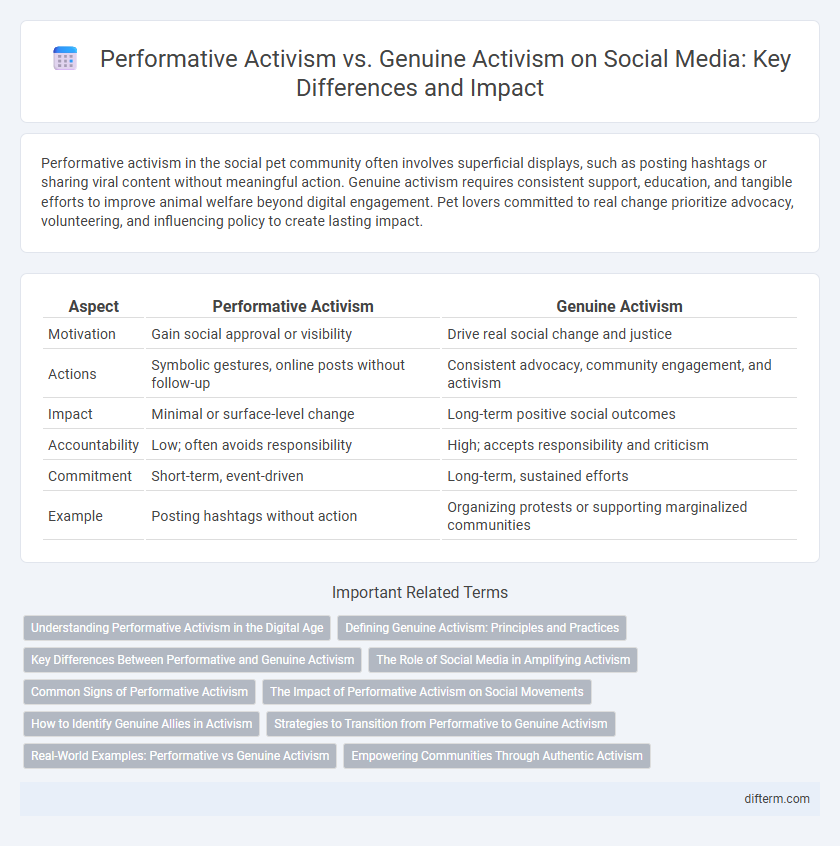Performative activism in the social pet community often involves superficial displays, such as posting hashtags or sharing viral content without meaningful action. Genuine activism requires consistent support, education, and tangible efforts to improve animal welfare beyond digital engagement. Pet lovers committed to real change prioritize advocacy, volunteering, and influencing policy to create lasting impact.
Table of Comparison
| Aspect | Performative Activism | Genuine Activism |
|---|---|---|
| Motivation | Gain social approval or visibility | Drive real social change and justice |
| Actions | Symbolic gestures, online posts without follow-up | Consistent advocacy, community engagement, and activism |
| Impact | Minimal or surface-level change | Long-term positive social outcomes |
| Accountability | Low; often avoids responsibility | High; accepts responsibility and criticism |
| Commitment | Short-term, event-driven | Long-term, sustained efforts |
| Example | Posting hashtags without action | Organizing protests or supporting marginalized communities |
Understanding Performative Activism in the Digital Age
Performative activism in the digital age often involves symbolic gestures or social media posts that signal support without driving substantial change, contrasting with genuine activism which entails sustained efforts and measurable impact. Digital platforms amplify the visibility of performative acts, making it crucial to discern between online virtue signaling and authentic advocacy for social justice. Understanding these dynamics enables more critical engagement with social movements and encourages accountability beyond superficial participation.
Defining Genuine Activism: Principles and Practices
Genuine activism centers on sustained commitment to social change through authentic engagement, measurable impact, and accountability to affected communities. Principles include transparency, inclusivity, and prioritizing marginalized voices, ensuring actions extend beyond symbolic gestures to substantive policy influence and grassroots mobilization. Practices such as continuous education, collaborative problem-solving, and resource allocation toward systemic change distinguish genuine activism from performative acts.
Key Differences Between Performative and Genuine Activism
Performative activism often centers on social media visibility and symbolic gestures without substantial impact, whereas genuine activism involves sustained efforts, tangible actions, and measurable outcomes toward social change. Performative actions prioritize personal or brand image over the cause, while genuine activists engage in continuous education, advocacy, and community involvement. The key difference lies in the authenticity of commitment and the effectiveness in addressing systemic issues.
The Role of Social Media in Amplifying Activism
Social media platforms serve as powerful tools for amplifying both performative and genuine activism by rapidly spreading messages to global audiences, often prioritizing visibility over impact. Hashtags and viral posts can raise awareness instantly but sometimes result in shallow engagement lacking meaningful action or long-term commitment. Authentic activism leverages these platforms to organize, mobilize communities, and drive tangible change beyond mere online displays of support.
Common Signs of Performative Activism
Common signs of performative activism include superficial social media posts lacking concrete action, prioritizing personal branding over community impact, and inconsistent behavior that contradicts stated values. This form of activism often involves using trending hashtags or symbolic gestures without supporting marginalized groups through sustained efforts. Genuine activism, in contrast, is characterized by ongoing commitment, meaningful engagement, and tangible contributions to social justice causes.
The Impact of Performative Activism on Social Movements
Performative activism often dilutes the core objectives of social movements by prioritizing visibility over tangible change, leading to widespread skepticism and disengagement among genuine supporters. Social movements affected by performative actions experience diminished credibility and reduced mobilization capacity, hindering their ability to achieve policy reforms or social justice goals. Authentic activism, characterized by sustained commitment and grassroots involvement, remains critical for driving meaningful and lasting societal impact.
How to Identify Genuine Allies in Activism
Genuine allies in activism demonstrate consistent support through meaningful actions such as amplifying marginalized voices, educating themselves on relevant issues, and participating in long-term initiatives rather than performative gestures like token social media posts. Key indicators include accountability, willingness to learn from criticism, and prioritizing community-led efforts over personal gain. Authentic activism fosters collaboration and empathy, contrasting sharply with performative activism's focus on visibility and self-promotion.
Strategies to Transition from Performative to Genuine Activism
Effective strategies to transition from performative activism to genuine activism include consistent community engagement, transparent accountability measures, and prioritizing long-term impact over short-term visibility. Activists should shift focus from symbolic gestures to actionable initiatives such as policy advocacy, resource allocation, and coalition building with marginalized groups. Embedding thorough self-reflection and education on social justice issues ensures sustained commitment and authentic allyship.
Real-World Examples: Performative vs Genuine Activism
Performative activism is exemplified by companies posting hashtags or statements during social movements without enacting policy changes or supporting affected communities, such as brands using #BlackLivesMatter during protests but lacking diversity initiatives. Genuine activism involves sustained efforts like Patagonia donating millions annually to environmental causes and advocating for policy reforms. The contrast highlights that performative activism prioritizes image over impact, while genuine activism embodies tangible commitment and measurable social change.
Empowering Communities Through Authentic Activism
Empowering communities through authentic activism involves genuine efforts that prioritize the needs and voices of marginalized groups rather than performative acts aimed at gaining social approval. True activism fosters sustainable change by engaging local leaders, supporting grassroots initiatives, and addressing systemic issues with transparency and accountability. This approach builds trust and resilience within communities, driving long-term social empowerment beyond symbolic gestures.
performative activism vs genuine activism Infographic

 difterm.com
difterm.com